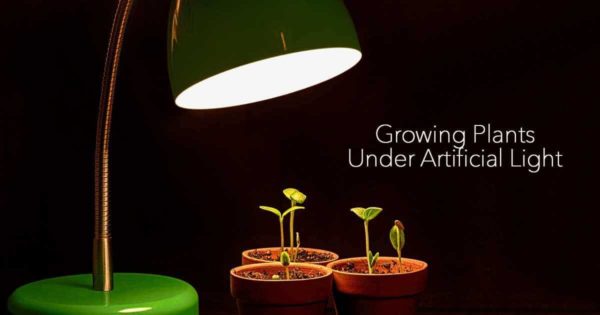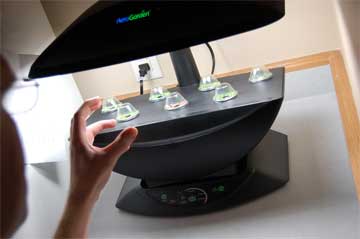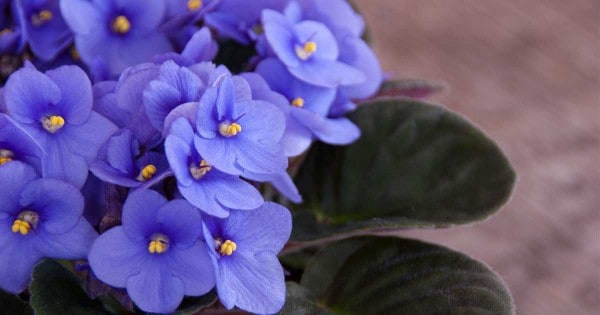Have you ever considered growing plants under artificial lights? Growing plants indoors with artificial light all the way to maturity is possible! Whether such a cultural method is worthwhile is another story.
But, the problem is not one of turning on enough light to make up for the lack of natural sunlight.

Indoor Grow Light Best Sellers
- Fluorescent Grow Light System with Stand Rack for Seed Plant Starting
- Indoor Grow Light System – 3-Tier Stand SunLite Light Garden With Plant Trays
- Sun System High-Pressure Sodium (HPS) 150 watt Grow Light Fixture with Ultra Sun Lamp
- T5 Grow Light (2ft 4 lamps) Fluorescent Hydroponic Bloom with Bulbs
Light has three “dimensions,” and is profoundly affected by its relationship to another factor of plant growth – temperature. For indoor gardening an understanding of all four factors is essential for growing plants under artificial light.
Because it is the least understood, the light-color temperature relationship should be explained first. Light and heat must be in balance.
When light is decreased, a lot of heat needs to be lowered in order to slow down plant growth to a point where the amount of light or illumination falling on the house plant is adequate for the level being maintained.
Thus, as the Winter days grow shorter, we cannot make up for the lack of the sun’s warmth by moving the plant to a warmer room.
Instead we should move it to a cooler spot, or make up for the lack of light by supplying artificial light for plants in a bathroom for example. Before we keep going too far, let’s answer this question.
Does A Plant Grow Better In Sunlight or Artificial Light?
Not being a scientist I cannot give a technical answer. Plants vary greatly in their requirements for light intensity.
Some tropical plants, including some houseplants like the iron plant (Aspidistra elatior), will survive under the light as dim as 50 foot candles. The flowering reaction of other plants is even more sensitive.
As little as one-foot candle can change a plant’s reaction and throw it into flowering, or prevent this response, depending on whether it is a long or short day plant. There are yet other plants that need 7,000 or more foot candles and refuse to flower unless exposed to full sun.
Full sun provides the full spectrum of light. I would assume that if you could provide the full light spectrum – blue light, red light and everything in between.
It would make no difference. However, I will say that I’ve seen some amazing picture perfect African violets grown under artificial lighting indoors.
Understanding Light And Plant Needs
Oddly enough, warm-weather plants can stand lower light intensities at higher temperature than cool-weather plants can.
Plants like cinerarias and calendulas needing relatively low temperatures will suffer more in a dark room at high temperatures than will the poinsettia, unless they get extra light.
 The popular AeroGarden
The popular AeroGarden
One of the weaknesses of the use of artificial lighting in growing plants has been the high heat generated by incandescent light bulbs. With fluorescent grow light bulbs, much of this handicap has been removed. Fluorescent tubes are capable of giving off a high output of light with less heat.
None the less, the three “dimensions” of light:
- Light intensity
- Light duration (Read How Long to Keep Grow Lights On Plants)
- Lighting spectrum
… present a problem.
Light intensity refers to the strength of the light, usually measured in foot candles. Photographic light meters are frequently rated in foot candles, so this term is not as esoteric as it once was.
Duration and intensity are often confused. The duration refers to the number of hours the light source sheds its radiation, but duration and intensity are not interchangeable.
You cannot make up for a short day by making the light brighter for fewer hours. There is some evidence that African violets can be grown as well with 600 foot candles for 18 hours as they can with 1,000 foot candles for 12 hours, but this is about the only case where the two qualities are not interchangeable.
Full-spectrum fluorescent light bulbs can, of course, be burned as long as is necessary. Light intensity is another problem. Because the radiation from these full-spectrum light bulbs or fluorescent tubes does not “project” well, plants must be placed within 12″ inches of the lighting fixture to get enough “grow light.”
For this reason, a standard type of light fixtures equipped with two 40-watt fluorescent lighting tubes will only light about 4 square foot of growing space – about 12″ inches wide and four feet long. Incandescent bulbs, on the other hand, can be suspended three feet above the plants. When used in this way, one 60-watt bulb will substitute for the sunlight on an area four feet by four feet.
However, this statement should not be interpreted to mean that either fluorescent lights or incandescent bulbs can be used to substitute for natural light from the sun on a full-time basis. For many species, such lighting can be used as a supplemental light source.
If the plant is one which reaching the flowering stage during the shorter days of the year, such extra light can help to hold it back. If it is one that needs long days for normal blooming, the extra lighting may make the difference between flowers and no flowers.

In the case of the poinsettia, for example, the usual failure of this plant when grown in the ordinary living room can be traced to the fact that the room is used at night.
Sun lamps for plants equal to just two or three foot candles is enough to interrupt flowering. When a family member reads their magazine, iPad or Kindle with the living-room lamp on, a poinsettia cannot be expected to flower in that room. It needs complete darkness for at least 13 to 14 hours a night before it will flower:
The chrysanthemum, also a short-day plant, is often controlled by supplying it with extra light until late in Winter. When flowers are wanted, the lights are turned off, and the plant flowers.
Thus chrysanthemums can, by shading in Summer and lighting in Winter, be made to flower at the convenience of the grower.
Comparing Types Of Artificial Light On Plant Growth
The amateur grower can use an artificial sunlight lamp for several purposes. One of the most interesting is to force tuberous begonias into bloom during the dark days of Winter. Being a long-day plant, the tuberous begonia needs extra light.
In the open, it stops forming flower buds when the length of the day drops below 12 hours. About mid-September, over the entire United States, tuberous begonias quit flowering and form tubers instead.
At Cornell University, they found that, if lights are used on the plants just before this condition happens, starting in mid-August, the tubers do not increase in size, and the plants keep on flowering all Winter long.
Either fluorescents or incandescents lighting systems can be used as light for indoor plants, by turning them on at four in the afternoon and off at nine at night. This is easily done with a timer like this.
A great many houseplants such as geraniums, Browallia, Heavenly Blue morning glories and other plants can be kept in bloom throughout the Winter by this same supplemental lighting.
Using artificial sunlight for plants source, foliage plants needing bright light like coleus will keep short and sturdy. English ivy will stop reaching for the sky, and remain short-jointed.
This practice can hardly be considered as growing plants under completely artificial light. How far we can go in this direction, depends on how much money we can afford to invest.
I have seen artificial lights that would exceed daylight by 50%, with air-conditioning equipment to pull down temperatures brought about by the heat thrown off by the lights. Yet, such layouts are beyond the ability and the purse of most amateur gardeners.
Growing Plants Indoors With Artificial Light In The Basement
What does fall into the realm of the possible is the growing of certain plants in a basement, entirely by artificial light such as African violets and Venus fly trap plants. All of these are what we call “forest floor” species.
They are plants which have been conditioned to survive under the trees of a forest, where light intensities are low. This group includes plants like such as African violets, carnivorous plants, all begonias, browallia, impatiens and many others. If a species will grow and flower in the shade, it can probably be grown entirely by artificial light.
Fluorescent grow lights made it possible for one couple to Grow Cattleya Orchids in their “Basement Greenhouse.”
This is where the third “dimension” of light comes in. Until now, the actual spectrum emitted by the source of light was not too important.
When all the light needed by the plant comes from an artificial light source, the light quality is vital. For vegetative growth and flowering, the shorter blue light waves (which are close to the invisible ultra-violet spectrum) seem to be important.
So, too, are the longer, red wavelengths, close to infra-red or invisible heat waves, but these are not needed in as large amounts. Fortunately, a very close approximation of natural daylight can be had by the use lighting system where daylight fluorescent tubes and light fixtures, are suspended about 10″ – 12″ inches above the plants.
The more light you can use on a given area, within reason, the better. The use of a completely-enclosed growing case and grow tents solves many of the problems involved in growing plants by artificial lights.
Inside such a case or grow tent:
- Light
- Heat
- Humidity
- Plant food
… can be controlled so closely that graphs representing each factor show as practically straight lines.
In the open basement, it is difficult to maintain humidity high enough for good growth. On the other hand, humidity can be kept at close to 100% without much difficulty in the enclosed plant case.
What can be grown in such a case, or on an open bench with high humidity?
One of the most satisfactory subjects is the tuberous begonia: light-sensitive plant, this species thrives on the long days that are possible under artificial light. If lights are kept on 24 hours a day, or are kept on 16 hours and off eight hours, very little difference in results.
A friend in LaGrange, Illinois, has grown tuberous begonias from seed to flowering, and kept the plants flowering continuously without a break. He has eight separate enclosed cases, growing a wide range of plant materials. African violets are particularly successful and impatiens also.

Artificial Light For Plants In Propagation
One of the most important uses for artificial light is in the propagation of plants; here light quality enters the picture again.
Daylight white fluorescent tubes supply the blue wavelengths light end of the spectrum, while the incandescent supplies visible red wavelengths light lacking in the colder light.
Normal growth of foliage and flowers is favored by the blue light end of the spectrum, while root formation is stimulated by the visible red light end.
Instead of the daylight tube, the so-called soft white fluorescent tubes is best for rooting cuttings. These need more of the red light end of the spectrum, which can be supplied by the use of this type of tube.
Results in a closed case or grow tent are sensational. I have propagated dozens of types of cuttings, with minimum loss and practically without attention. Once the cuttings are “stuck” in the pot mix of soil or flats, the lid is closed and need not be opened, except for inspection, until the rooted cuttings are removed.
A highly satisfactory use for artificial light has been in the forcing of Dutch bulbs without a sunny window. Hyacinths, tulips, and narcissi are potted as soon as received and kept in a dark location at 48° degrees Fahrenheit degrees until the shoots are 2-3″ inches out of the pots.
Long, cold storage treatment is unnecessary except when bulbs are to be held back for later forcing. Once the shoots are developed to a length of 3′ inches, the pots are placed under fluorescent tubes.
Two 40-watt tubes suspended 10 inches above the pots will light an area 12″ x 48″ inches. The temperature should be kept as close to 55° degrees Fahrenheit as possible.
In forcing bulbs, I find that excellent pot plants can be grown with only fluorescent tubes. However, if the flowers are to be used for cutting, the addition of a 60-watt incandescent bulb to the two tubes seems to produce a plant lasting longer in mineral-free water.
Artificial Light Used To Replace Or Supplement Direct Sunlight
Metal Halide Light
Metal Halide Light is a bright light with exceptionally long life span. They require a ballast kit to operate. You’ll often find Metal Halide fixtures used for vegetative growth stage and High Pressure Sodium (HPS) fixtures for the flowering stage. Learn More Here
High-Pressure Sodium Grow Light
 High-Pressure Sodium (HPS) grow lightsHigh-Pressure Sodium (HPS) grow lights are High-Intensity Discharge (HID) lights. The light they produce is in the orange/red spectrum an ideal lighting for the flowering stage. Many cannabis plant growers claim high-pressure sodium lights are ideal for flowering marijuana plants. More Details Here
High-Pressure Sodium (HPS) grow lightsHigh-Pressure Sodium (HPS) grow lights are High-Intensity Discharge (HID) lights. The light they produce is in the orange/red spectrum an ideal lighting for the flowering stage. Many cannabis plant growers claim high-pressure sodium lights are ideal for flowering marijuana plants. More Details Here
Compact Fluorescent Grow Lights
Compact Fluorescent Plant Grow Lights (CFLs) – These energy efficient grow lights for houseplants are growing in popularity for both propagation and plant growth. While not as efficient or with as much intensity as HID lights, fluorescent deliver better color and spectrum light providing more useful light per watt to the plant.
When used in numbers these lights are extremely effective. For the vegetative stage of growth use the 6500K blue light spectrum placed 6″-12″ above the plant canopy. During the flowering phase use the warm, red 3000k spectrum. More On CFL’s Here
Using LED Grow Lights Indoor Plants
LED grow lights (light-emitting diode) are relative “newcomers” to the indoor artificial lighting scene. The basic advantages to them include lower heat, smaller, long lasting, less energy, very efficient.
One of the downsides is their cost can be high to get the lighting needed to grow plants well indoors. However, as LED lights become more mainstream expect the price to go down over the next few years. More Details Here
In Closing
Can plants grow in artificial light?, Yes!
Growing plants indoors with artificial light can be lots of fun. Most homeowners can get started with a simple setup of two 40-watt tubes suspended over a table 10″ inches above the plants. Try starting with African violets.

 The popular AeroGarden
The popular AeroGarden

 High-Pressure Sodium (HPS) grow lights
High-Pressure Sodium (HPS) grow lights